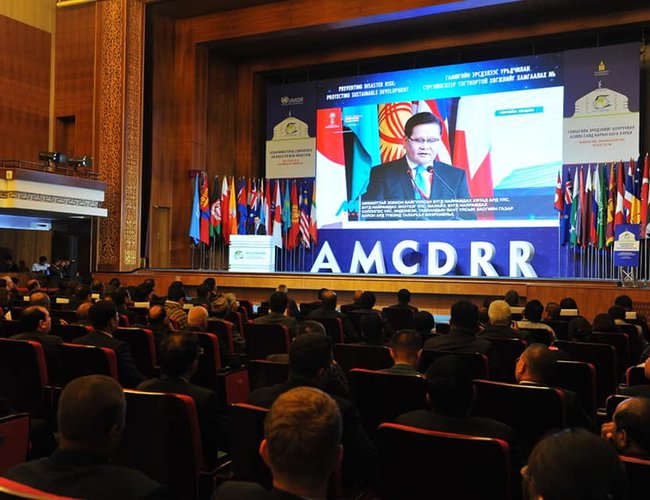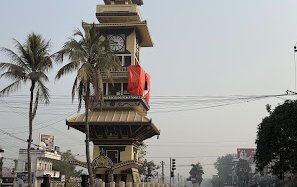
The Asian Ministerial Conference on Disaster Risk Reduction (AMCDRR) concluded in Ulaanbaatar, capital city of Mongolia, with 28 declaration points on 6th July 2018. The declaration recognizes its historic foundations, identifies action points to be undertaken in the coming days and makes commitments to happen the actions on the ground. The declaration, in nut shell, embraces various dimensions of disaster risk reduction including strategies, policies and legislation; and social, financial, technological, environmental, institutional and political aspects of DRR. One of the action points is “Urgently accelerate actions to develop and implement national and local strategies on disaster risk reduction, thereby achieving target (e) of the Sendai Framework by 2020”. The target (e) of Sendai Framework for DRR is “substantially increase the number of countries with national and local disaster risk reduction strategies by 2020”.
This particular point of declaration is an important one that opens the door and lays down the foundation for other points of declarations of the conference. It is because without having strategies, policies, plans and legislation, the other points of declarations related to social, financial, technological, environmental, institutional and political aspects of DRR are unlikely to be happen formally on the ground effectively. This point of declaration is also vital and timely for Nepal especially at a time when Nepal is undergoing through policy and institutional restructuring for Disaster Risk Reduction and Management (DRRM) as Nepal has embarked on to new governance system under the political system of Democratic Republic. Nepal has already DRRM Act 2017 in hand and currently it is under the stage of rolling it out from National to province and local levels. The AMCDRR 2018 declaration provides a moral support to Nepal and strengthens the confidence in developing and implementing DRRM strategies, policies and legislation under the Act. It also adds obligations to accelerate the accomplishment of institutional and policy requirements for DRRM in the coming two years before the next AMCDRR 2020 in Australia.
The target time, 2020, is also comfortable to Nepal. For Nepal, it is not only a commitment to regional and global communities, but it is also the need of the country for reducing the risk of disaster that takes lives of nearly 500 people and cause loss and damage of properties worth at least 2-5% of country’s GDP annually, which in extreme cases like in 2015 Gorkha earthquake reach to as high as loss of 9,000 lives and 33% of GDP by a single event.
For a full implementation of DRRM Act 2017, number of strategies, legislation and institutions for DRR and Management are necessary as a matter of urgency. The Act asks for formation of a National Disaster Risk Reduction and Management Council (NDRRMC) under the chair of Prime Minister as the apex body. The Council will only be full-fledged with three DRR/M experts as the members who are yet to be identified as of now. To execute the decisions of the council, the Minister for Home Affairs will head an Executive Committee. The Act also provisions that the Ministry of Home Affairs (MoHA) will form a committee of DRR/M Experts from various spheres of DRR/M to support the Council and the Executive Committee technically. The committee of experts has yet to be formed together with their functions, duties and authorities. Under the direct control and supervision of Executive Committee, a National Disaster Risk Reduction and Management Authority (NDRRMA) will be functioned as secretariat for the Council and Executive Committee. However the government needs formulation of legislation for establishing the authority.
Similarly at the province level, a Province Disaster Management Committee (PDMC) under the chair of Province Chief Minister is to be established. Guiding documents yet to be prepared to form the PDMC together with the working procedures for the committee. Each district also should have a District Disaster Management Committee (DDMC) under the chair of Chief District Officer (CDO). Currently the DDMC is also lacking operating document to be prepared under the Act. The Local Disaster Management Committee (LDMC) at municipal levels under the chair of Chairperson or Meyer of municipality, need legal documents to guide the formation of committee regarding to who will be the members to the committee and what will be the functions, duties and authorities of the committee.
As mentioned before, the timing of outcomes of AMCDRR 2018 coincides with ongoing implementation of NDRRMA 2017 in Nepal which needs formulation of number of strategies and legislations for establishing and operationalising the institutions for DRR/M. It offers an opportunity to Nepal to demonstrate innovations, leadership and importance of the declarations by establishing required institutions and strategies for DRR/M before the next AMCDRR 2020 to share the entire learning out of the process with regional and global communities. A delay in devising and implementing essential institutions, strategies and legislations for DRR/M, will lead to more loss and damage of lives and properties resulting into retardation of pace of achieving sustainable development goals
Gurung is head of DRR and Climate Change Program, Practical Action South Asia Office in Nepal. The views are personal, not related with the organisation.

Gehendra B. Gurung
Gurung is a Disaster Risk Reduction and Climate Change Adaptation Specialist. He can be reached at gehendra363@gmail.com
- Localizing Climate Change Actions
- Sep 25, 2019
- Nepal Must Adopt “Green Development Path” Earliest Possible
- Sep 08, 2019
- Adaptation To Climate Change - From NAPA to NAP
- Mar 04, 2019
- Climate Change From NAPA to NAP
- May 03, 2018















